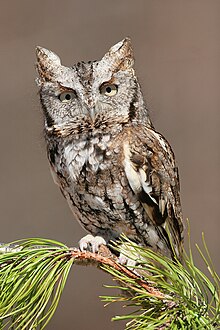Strigidae
| True owl Temporal range: Early Eocene to present |
|
|---|---|
 |
|
| Eastern screech owl | |
| Scientific classification | |
| Kingdom: | Animalia |
| Phylum: | Chordata |
| Class: | Aves |
| Order: | Strigiformes |
| Family: |
Strigidae Vigors, 1825 |
| Genera | |
|
some 25, see text |
|
| Synonyms | |
|
Striginae sensu Sibley & Ahlquist |
|
some 25, see text
Striginae sensu Sibley & Ahlquist
The true owls or typical owls (family Strigidae) are one of the two generally accepted families of owls, the other being the barn owls (Tytonidae). The Sibley-Ahlquist taxonomy unites the Caprimulgiformes with the owl order; here, the typical owls are a subfamily Striginae. This is unsupported by more recent research (see Cypselomorphae for details), but the relationships of the owls in general are still unresolved. This large family comprises around 189 living species in 25 genera. The typical owls have a cosmopolitan distribution and are found on every continent except Antarctica.
While typical owls (hereafter referred to simply as owls) vary greatly in size, with the smallest species, the elf owl, being a hundredth the size of the largest, the Eurasian eagle-owl and Blakiston's fish owl, owls generally share an extremely similar body plan. They tend to have large heads, short tails, cryptic plumage, and round facial discs around the eyes. The family is generally arboreal (with a few exceptions like the burrowing owl) and obtain their food on the wing. The wings are large, broad, rounded, and long. As is the case with most birds of prey, in many owl species females are larger than males.
Because of their nocturnal habits, they tend not to exhibit sexual dimorphism in their plumage. The feathers are soft and the base of each is downy, allowing for silent flight. The toes and tarsi are feathered in some species, and more so in species at higher latitudes. Numerous species of owls in the genus Glaucidium and the northern hawk-owl have eye patches on the backs of their heads, apparently to convince other birds they are being watched at all times. Numerous nocturnal species have ear-tufts, feathers on the sides of the head that are thought to have a camouflage function, breaking up the outline of a roosting bird. The feathers of the facial disc are arranged in order to increase sound delivered to the ears. Hearing in owls is highly sensitive and the ears are asymmetrical allowing the owl to localise a sound in multiple directions. In addition to hearing, owls have massive eyes relative to their body size. Contrary to popular belief, however, owls cannot see well in extreme dark and are able to see well in the day.
...
Wikipedia
